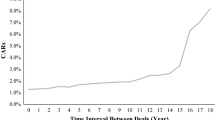Abstract
We study mergers and acquisition during the period from 1988 to 2005 and examine the impact of merger market intensity, i.e., merger waves, on the means of payment and the returns to target and acquirer shareholders. We use two proxies to measure the intensity of the merger market—the number of mergers in the trailing 12-month period prior to a merger and the total dollar volume of mergers in the trailing 12-month period prior to a merger—and use these measures to define hot and cold merger markets. We find that stock financing is more common after a stock price run-up for the acquiring firm and in hot merger markets. We also find that the acquisition premium is larger in hot merger markets. Returns to acquiring company shareholders are lower for stock financed mergers and are lower when merger markets are intense. Our results are consistent with the predictions of the behavioral theory for merger waves.
Similar content being viewed by others
Notes
We would like to thank the referee for the suggestion.
References
Andrade G, Mitchell M, Stafford E (2001) New evidence and perspectives on mergers. J Econ Perspect 15:103–120
Ashraf R, Jayaraman N (2005) Institutional investors’ trading behavior in mergers and acquisitions, Working Paper, Georgia Institute of Technology
Barclay M, Warner J (1993) Stealth trading and volatility: which trade moves prices? J Financ Econ 3:281–305
Brown SJ, Warner JB (1985) Using daily stock returns: the case of event studies. J Financ Econ 14:3–32
Chang S (1998) Takeovers of privately held targets, methods of payment, and bidder returns. J Finance 53:773–784
Faccio M, Masulis RW (2005) The choice of payment method in European mergers and acquisitions. J Finance 60:1345–1388
Hansen RG (1987) A theory for the choice of exchange medium in mergers and acquisitions. J Bus 60:75–95
Heckman JJ (1979) Sample selection bias as a specification error. Econometrica 47:153–161
Holmstrom B, Kaplan S (2001) Corporate governance and merger activity in the United States: making sense of the 1980’s and 1990’s. J Econ Perspect 15:121–144
Jensen MC (1986) Agency costs of free cash flow, corporate finance and takeovers. Am Econ Rev 26:654–665
Jovanovic B, Rousseau P (2002) The Q-theory of mergers. Am Econ Rev 92:198–204
Lang L, Stulz RM, Walking RA (1989) Managerial performance, Tobin’s q and the gains from successful tender offers. J Financ Econ 24:137–154
Lang L, Stulz RM, Walking RA (1991) A test of the free cash flow hypothesis: the case of bidder returns. J Financ Econ 29:315–335
Moeller SB, Schlingemann FP, Stulz RM (2004) Firm size and the gains from acquisition. J Financ Econ 73:201–228
Myers SC, Majluf NS (1984) Corporate financing and investment decisions when firms have information that investors do not have. J Financ Econ 13:187–221
Puri M (1996) Commercial bank in investment banking: conflict of interest or certification role? J Financ Econ 40:373–401
Rhodes-Kropf M, Robinson DT, Viswanathan S (2004) Market valuation and merger waves. J Finance 59:2685–2718
Rhodes-Kropf M, Robinson DT, Viswanathan S (2005) Valuation waves and merger activity, the empirical evidence. J Financ Econ 77:561–603
Rosen RJ (2006) Merger momentum and investor sentiment: the stock market reaction to merger announcements. J Bus 79:987–1017
Safieddine A, Titman S (1999) Leverage and corporate performance: evidence from unsuccessful takeovers. J Finance 54:547–580
Shleifer A, Vishny R (2003) Stock market driven acquisitions. J Financ Econ 70:295–311
Travlos NG (1987) Corporate takeover bids, methods of payment and bidding firm’s stock returns. J Finance 42:943–963
Acknowledgments
We would like to thank Nagpurnanand R. Prabhala and an anonymous referee for useful comments on the paper.
Author information
Authors and Affiliations
Corresponding author
Appendix
Appendix
We use a two-step Heckman (1979) selectivity bias adjustment as described below. Our approach parallels the approach used by Puri (1996).
The model for the returns to the target and acquirer returns (separate regressions) is:
where Y is the return (the target or the acquirer), X is the vector of independent variables and D is a dummy variable that is 1 if the acquisition is stock financed and 0 otherwise.
The acquirer uses stock to finance the acquisition based on the following model:
where z is the vector of observable factors in determining the acquirer’s decision to use stock financing and b is the vector of coefficients. η is the vector of unobservable factors. Assuming that η~Ν(0, σ2),
where LambdaStock = n(.)/N(.), and LambdaNon-Stock = −n(.)/l − N(.), and n(.) and N(.) are the standard normal density and the standard cumulative distribution function, respectively.
We can re-write Eq. (1) as follows,
As Puri (1996) shows, consistent estimates can be obtained by a two-step process. First, we estimate the PROBIT likelihood function for stock financed mergers. This allows us to estimate Lambda for stock and non-stock mergers. We can then estimate w by OLS regressions. We correct for the OLS standard errors by using a robust regression model.
The inference on w is as follows. If w < 0, returns are lower in a stock merger. If w > 0, returns are higher in a stock merger. If w = 0, returns are independent of the means of payment.
Rights and permissions
About this article
Cite this article
Chidambaran, N.K., John, K., Shangguan, Z. et al. Hot and cold merger markets. Rev Quant Finan Acc 34, 327–349 (2010). https://doi.org/10.1007/s11156-009-0133-z
Received:
Accepted:
Published:
Issue Date:
DOI: https://doi.org/10.1007/s11156-009-0133-z
Keywords
- Hot and cold merger markets
- Merger quality
- Acquisition premiums
- Announcement-period returns
- Behavioral theory of mergers




